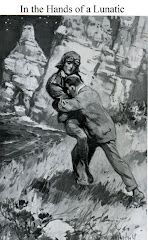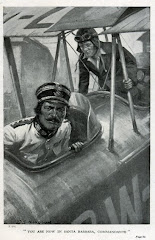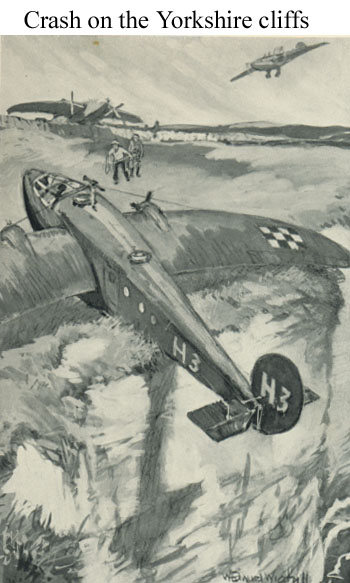Colin Standish of the Air Police is the hero of one in a series of books about flying policemen that were written by Percy F. Westerman during the 1930s. It is not the first adventure of Standish and his friend and fellow pilot Don Grey but it is the first of the Air Police stories.
The county of Yorkshire features very strongly in this book as it does in several of the other ‘Standish’ adventures. There are lots of generalised pictures of the Yorkshire Coast and some very specific ones of places in the Dales.
Both Don Grey and Colin Standish are recruited into the newly formed Royal Air Constabulary. Their experience with Far Eastern Airlines Limited and their relationship with Sir Rugglestone Corton means that they are able to get into the officer corps of the Air Police after a test at Scotland Yard, a medical and an interview with the powerful baronet. They ask for excitement and he decides to have them posted to the North Eastern division which is based at Hawkscar in Yorkshire. It doesn’t take much imagination to realise that Hawkscar is based upon the name and location of the real Ravenscar. The aerodrome is described thus:-
‘situated between Flamborough Head and Scarborough and about three miles from the coast.’
The junior officers are to live under canvas whilst the senior officers have been billeted at a hotel in Filey. Very soon Standish finds himself involved in a dangerous situation as a fault with his engine sees his aircraft out over the North Sea, desperately trying to glide or ‘volplane’ back to the coast near Bridlington. The accompanying illustration shows how his tremendous crash leaves him perched on the brink of destruction.
The next chapter opens with one short sentence.
‘Fortunately Colin Standish kept his head..’
However, this is not the last of the perils in the skies over Eastern Yorkshire. Soon Colin is detailed to follow a large aircraft which appears to be in the process of gun-running to a secret rendezvous in the Yorkshire Dales. However, both errors and confusions creep into the assignment and Standish finds himself having to make a profound apology whilst at the same time setting off on the trail of some extremely dangerous criminals.
This time the location is more precise. ‘In a valley between Wensleydale and Swaledale,,,,There’s a small village called Muker three miles to the north of us and the market town of Hawes four miles to the south. …. and along the ridge above us is a mountain road called the Buttertubs Pass’.
Gunshots, knockouts a stumbles into big holes soon follow. Standish has to be carried back by stretcher.
However, Don Grey is not without his own share of perilous episodes. Whilst Standish recovers from his latest escapade Grey finds himself making a forced landing not far from Flamborough Head, not far from Flamboro’ village. Somehow he finds himself on the brink of a spot called Robin Lythe’s Hole and then later struggling with a madman who wants to leap over the edge and ‘float’ down the beach. After another narrow escape the two chums are able to discuss their suspicions of the man they suspect of sabotage.
Standish takes a spot of leave and goes for a walk near Wetwang and sets off making his way back to Bridlington. Soon he discovers that members of the gang he has been busy frustrating are on his trail and determined to have their revenge. Only the intervention of his old pal Metcalfe rescues him from another disaster. Standish clearly is a marked man and his superiors advise more caution.
A more amusing episode takes place over the city of York where Standish has to pursue someone who is ‘buzzing’ the city. The criminal is forced down and Standish follows in pursuit, landing next to the main York-Scarborough Road. Soon Colin is astonished to find that he is pursuing a ‘feminine form’. The local population are more inclined to get in the way than assist an officer in the performance of his duties.
‘A short distance away was a charabanc with a party of cricketers on their way to play against a Malton team, The alighted en masse and, armed with bats and stumps, prepared to attack the holders-up of the other car.’
The fugitive is finally collared and we learn the true identity and gender of the person who caused so much trouble.
Westerman provides an effective climax to the book by sending Standish and Grey away on a foreign assignment and by allowing Colin to return to Yorkshire on an unorthodox flight where he has to cling on for dear life. The end comes at Greenhow Hill where police congregate from Pateley Bridge, Ripley, Harrogate, Otley, Skipton and Grassington. The villains are there with their cargo, the unconscious Colin Standish a raging fire and a concealed load of dynamite about to go off.
That is bringing things to an end with a bang – or not quite - for Colin has to survive for more adventures which we look at on another occasion.
Saturday 4 April 2009
Friday 3 April 2009
In Defiance of the Ban - Percy F.Westerman
The Yorkshire interest of this book lasts for the first 23 pages. There are 320 pages in the book - most of which is concerned with an expedition to a fictional South American country.
Unfortunately none of the illustrations concern themselves with events in this description of Yorkshire topography.Alan Brampton builds his own aircraft which has much in common with the flight characteristics of an early helicopter. Without a licence or a certificate of air-worthiness he decides to embark upon his maiden flight. We are not at all surprised when the 'flip' into the air lends in an accident that spares his life but which means that he is laid up in a large Yorkshire house for quite a period. It seems,however, he has also crashed his way into an adventure.
The flight begins in the Cleveland Hills district of North Yorkshire. The engines for the new plane have been picked up in an auction sale of motorbike parts in Darlington. We learn that the handyman who helped Alan has gone into Stockton for the day. These reassuring real Yorkshire names mean that we don't pay much attention to the name of the local village which appears to be called Mexworth. The top of Mexworth Church tower is eighty feet from the ground compared with the 200 feet he soars near the beginning of his first flight.
What he sees next is most interesting,'He could discern the smoking factory chimneys of Darlington and Teeside on his right. On his left the Cleveland Hills, many miles away, still cut the clear skyline, while ahead the gaunt Pennines limited his range of vision in that direction.'He manages to turn his flimsy craft to point to the north east.'Ahead, beyond the expanse of land, he could discern the sea from Tynemouth to Flamborough Head.'He moves onwards and in ten minutes he is over Saltburn.
He flies south along the coast and passes Runswick Bay and takes in the sight of St. Hilda's Abbey in Whitby.Then he decides that he should make for home and remarks that the course of the little river would take him back in sight of Mexworth. For a while the 'silvery Esk' guides him on his way but then trouble arrives in the form of bad weather. He has to get down, rather drastically, in very bad weather. To all intents and purposes that is the end of Yorkshire in this book !
It is just the beginning of the expedition to South America and more flying and then underwater adventures.
Unfortunately none of the illustrations concern themselves with events in this description of Yorkshire topography.Alan Brampton builds his own aircraft which has much in common with the flight characteristics of an early helicopter. Without a licence or a certificate of air-worthiness he decides to embark upon his maiden flight. We are not at all surprised when the 'flip' into the air lends in an accident that spares his life but which means that he is laid up in a large Yorkshire house for quite a period. It seems,however, he has also crashed his way into an adventure.
The flight begins in the Cleveland Hills district of North Yorkshire. The engines for the new plane have been picked up in an auction sale of motorbike parts in Darlington. We learn that the handyman who helped Alan has gone into Stockton for the day. These reassuring real Yorkshire names mean that we don't pay much attention to the name of the local village which appears to be called Mexworth. The top of Mexworth Church tower is eighty feet from the ground compared with the 200 feet he soars near the beginning of his first flight.
What he sees next is most interesting,'He could discern the smoking factory chimneys of Darlington and Teeside on his right. On his left the Cleveland Hills, many miles away, still cut the clear skyline, while ahead the gaunt Pennines limited his range of vision in that direction.'He manages to turn his flimsy craft to point to the north east.'Ahead, beyond the expanse of land, he could discern the sea from Tynemouth to Flamborough Head.'He moves onwards and in ten minutes he is over Saltburn.
He flies south along the coast and passes Runswick Bay and takes in the sight of St. Hilda's Abbey in Whitby.Then he decides that he should make for home and remarks that the course of the little river would take him back in sight of Mexworth. For a while the 'silvery Esk' guides him on his way but then trouble arrives in the form of bad weather. He has to get down, rather drastically, in very bad weather. To all intents and purposes that is the end of Yorkshire in this book !
It is just the beginning of the expedition to South America and more flying and then underwater adventures.
Thursday 2 April 2009
One is One - Barbara Leonie Picard
The hero of this novel was born on the 26th December,1309 - St. Stephen's Day. At first he does not seem to be the sort of individual who is going to turn out to be a hero. The first of the three sections of the book is entitled AMILE and it concerns the one creature that starts to give a meaning to his life.
From his earliest days Stephen de Beauville, the son of Robert de Beauville, Earl of Greavesby in Yorkshire, has been frightened of dogs. Every member of his large family spends a large portion of their time in cruel teasing as they torment him with his fear of every member of the canine world. His elder half-brothers are openly contemptuous of what they see as nothing but cowardice. Life is one long round of fear and misery and there seems no way that he can live up to the martial spirit of his brothers and sisters. His father rapidly makes the decision that nothing but a life with monks will he suitable for his timid son.
For some strange reason he is presented with a small and sickly puppy, the runt of the litter, as a means of tormenting him even further. He decides to kill it but relents when the puppy turns to him in affection and trust. He gradually overcomes his fear and makes his mind to keep the little dog and names it Amile. For the first time in his life he feels love for another creature and that love is returned.
Amile becomes his day and night companion and grows up to be a handsome and valuable hound which is now coveted by Stephen's jealous older half-brothers. The world changes for Stephen and he begins to develop as a person in many different ways. However, disaster overtakes him again when he reaches his thirteenth birthday and his father has decided it is time to take him to Richley Abbey and hand him over to the abbot. It is the end of his life with Amile. It seems like the end of his world. There is then a brutal solution to his unasked for problem.
The second and third stages of Stephen's life are also marked by two characters who have a profound effect upon his destiny. PAGAN and THOMAS both introduce him to other aspects of his character that he never thought were within him. One influence leads him to Berkshire and Worcesterhire whilst the other takes him north again as far as Berwick and the war against the Scots and later back to the world of his family. He has become a very different person. He has learned that "The coward, being afraid of nearly everything, is alone capable of the highest courage."
The world is now ready to accept him in a way he never thought possible. Yet the choice he makes at the end is another tremendous step and an extraordinary leap of faith. The book involves two journeys - one that is a geographical exploration of parts of the north-the other a deeper journey into the quest for his own soul.
From his earliest days Stephen de Beauville, the son of Robert de Beauville, Earl of Greavesby in Yorkshire, has been frightened of dogs. Every member of his large family spends a large portion of their time in cruel teasing as they torment him with his fear of every member of the canine world. His elder half-brothers are openly contemptuous of what they see as nothing but cowardice. Life is one long round of fear and misery and there seems no way that he can live up to the martial spirit of his brothers and sisters. His father rapidly makes the decision that nothing but a life with monks will he suitable for his timid son.
For some strange reason he is presented with a small and sickly puppy, the runt of the litter, as a means of tormenting him even further. He decides to kill it but relents when the puppy turns to him in affection and trust. He gradually overcomes his fear and makes his mind to keep the little dog and names it Amile. For the first time in his life he feels love for another creature and that love is returned.
Amile becomes his day and night companion and grows up to be a handsome and valuable hound which is now coveted by Stephen's jealous older half-brothers. The world changes for Stephen and he begins to develop as a person in many different ways. However, disaster overtakes him again when he reaches his thirteenth birthday and his father has decided it is time to take him to Richley Abbey and hand him over to the abbot. It is the end of his life with Amile. It seems like the end of his world. There is then a brutal solution to his unasked for problem.
The second and third stages of Stephen's life are also marked by two characters who have a profound effect upon his destiny. PAGAN and THOMAS both introduce him to other aspects of his character that he never thought were within him. One influence leads him to Berkshire and Worcesterhire whilst the other takes him north again as far as Berwick and the war against the Scots and later back to the world of his family. He has become a very different person. He has learned that "The coward, being afraid of nearly everything, is alone capable of the highest courage."
The world is now ready to accept him in a way he never thought possible. Yet the choice he makes at the end is another tremendous step and an extraordinary leap of faith. The book involves two journeys - one that is a geographical exploration of parts of the north-the other a deeper journey into the quest for his own soul.
Subscribe to:
Posts (Atom)



















